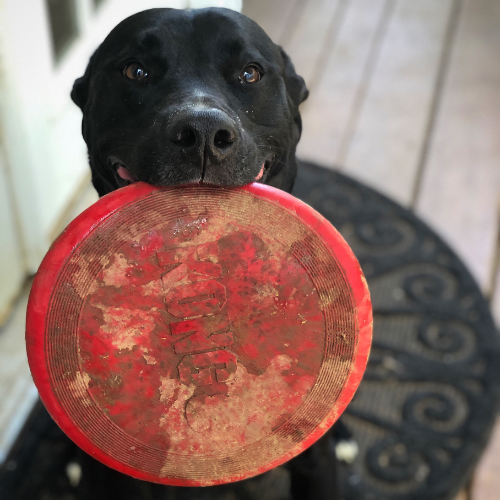Big Problems Deserve Thoughtful Solutions
Dog Behavior Consulting
Understanding Behavior Challenges

Who We Help
We Work with Dogs Who
- Bark, growl, or lunge at people or other animals
- Resource guard toys, food, or people
- Struggle with fear, anxiety, or phobias
- React strongly to being handled, leashed, or left alone
- Have bitten (or come close) and need a serious, structured plan
- Are slightly shady
Why Choose Good Human Dog Training?
Trust has to be earned, but we don’t come empty-handed. We come with treats and street cred.
- Experience That Matters. Over 20 years working with complex behavior cases across shelters, homes, and service dog settings.
- Credentials That Count. Certified Dog Behavior Consultant (IAABC), CPDT-KA, and Karen Pryor Academy CTP.
- Welfare-First, Always. No intimidation, no “balanced” methods, no shock. Just science, skill, and serious empathy for both ends of the leash.
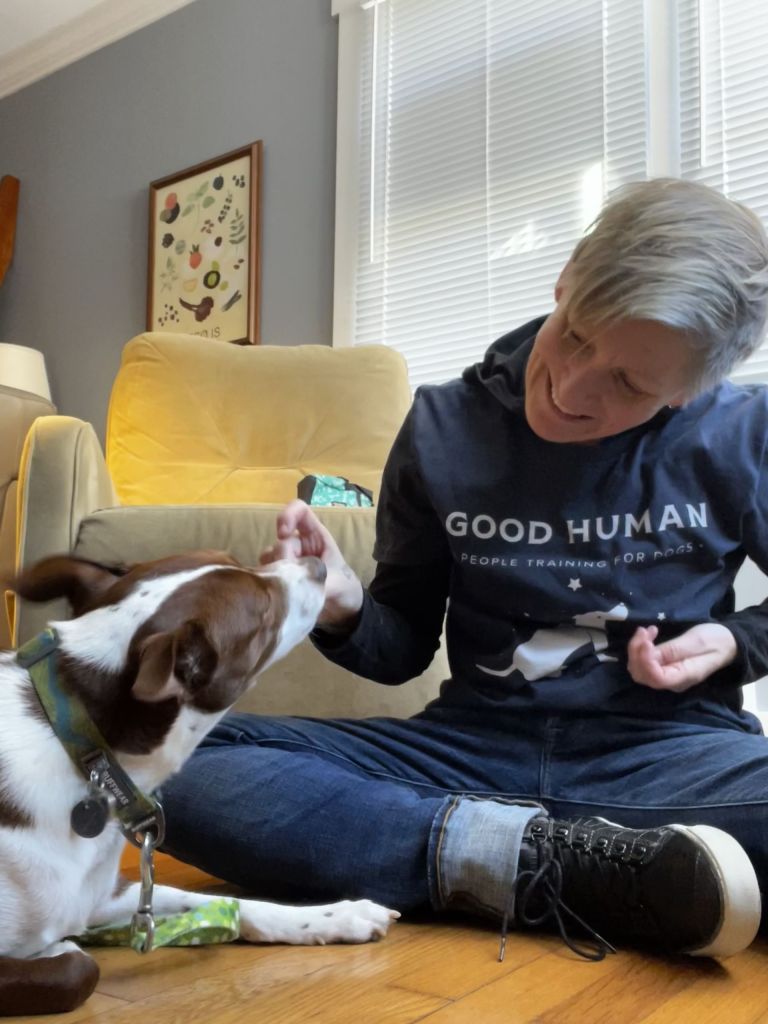
Your Training Roadmap
We combine deep behavioral expertise with real-world practicality. Every plan is personalized to your dog, your home, and your capacity. It’s a true partnership.
One important note: real behavior change takes time. A single session is for assessment and immediate steps. The transformation package is where you’ll see long-term results.
Our package follows a clear four-stage model so you always know where you are and what comes next.
Stage 1: Assessment
Before we meet, I review your dog’s history and may ask for more details, safety information, or vet input if health could be a factor. During your first 90-minute session, I gather the full picture of your dog’s behavior, environment, health, and history. This allows me to design a realistic, goal-driven plan tailored to your life.
Stage 2: Immediate Management
We start with strategies that improve safety and reduce stress right away. This may include introducing a muzzle in a safe, positive way, adjusting routines, or other management techniques. These first steps give you breathing room while deeper training is underway.
Stage 1 and Stage 2 are included in your initial consultation.
Stage 3: Skill Building
We teach you and your dog new skills using humane, evidence-based methods. These exercises build emotional regulation, responsiveness, and trust. After each session, you’ll have clear practice assignments. Short daily sessions make the biggest difference.
Stage 4: Real-World Application
Once you and your dog have solid skills, we take them on the road. We’ll work from your home to your yard to your neighborhood until you feel confident handling real-life situations together.
- Depending on your goals, you may need additional sessions beyond the package. We'll discuss this as we go.
- Appointments are scheduled about two weeks apart for steady progress.
- You may be asked to adjust your dog’s routine or activities, either temporarily or long term.
- You will receive clear exercises to practice between sessions. The most successful clients practice a little bit every day.
- See the FAQs below for more details.
Pricing
Transparent Pricing, No Surprises
We believe you should always know exactly what you’re investing in. Our pricing is clear, straightforward, and all-inclusive. No hidden fees or surprise add-ons. Every package comes with personalized support and honest expectations, so you can focus on helping your dog and not deciphering fine print.
PACKAGE
Behavior Transformation
$437
in person
$323
virtual
Includes
- Complete assessment of your dog's behavior, history, and training background
- Management techniques to prevent and reduce unwanted behaviors
- Educational and resources on dog behavior and stress signals
- Flexible plan customized to your dog, busy schedule, and home environment
- Skill-building sessions for Real Behavior Change
- Fun practice activities to reinforce training between sessions and build confidence
- Unlimited email and phone support throughout your program. Your success matters to me!
SINGLE SESSION
Initial Behavior Consultation
$175
in person
$130
virtual
Includes
- Complete assessment of your dog's behavior, history, and training background
- Management techniques to prevent and reduce unwanted behaviors
- Educational discussion and materials on dog behavior and stress signals
- One consultation gets you started, but real change happens with ongoing support.
Most clients see lasting results through follow-up sessions that adjust your plan, solve problems, and keep you on track.
Single sessions rarely create permanent change. Our Behavior Transformation Program does.
EXISTING CLIENTS
Skill Building Sessions
We offer virtual sessions, in-person visits, and package options that combine both to fit your needs and schedule.
Includes
- Review progress since the last session and troubleshoot challenges.
- Adjust management strategies as your dog’s needs change.
- Teach and practice new skills that build confidence, calm, and cooperation.
- Coach you on when and how to use these skills in daily life.
- Gradually practice in real-world settings, moving from home to yard to neighborhood.
- Apply training in real-world settings, from home to neighborhood.
- Modify the training plan as your dog progresses, keeping it realistic and sustainable.
Have Any Questions?
FAQ's
You have questions? I likely have answers. Here are the most frequently asked questions from our Behavior Path clients.
Still have questions?
Can you train my dog for me?
In some cases, I can kickstart your dog’s learning by visiting 3-4 times per week to build foundational skills, then transfer those techniques to you.
But here’s the key difference: behavioral change isn’t like teaching tricks. Teaching a dog to “sit” happens quickly, but helping them feel differently about their triggers is an emotional journey that requires your consistent involvement between our meetings.
Will you help us with real-life triggers?
Absolutely! This is where the magic happens. Once your dog has the right tools, we’ll work together around actual dogs, people, or whatever sets them off, building confidence step by step.
Virtual clients get the same support: I’ll coach you live through your device, or we’ll analyze videos of your practice sessions to fine-tune your approach.
Can I have others join our sessions?
Of course! Everyone who interacts with your dog should be on the same page. I love working with the whole support network because consistency across all handlers makes everything click faster.
Do you guarantee results?
I don’t offer guarantees, and here’s why: successful behavior change depends on many factors beyond my control. Even with the best training plan, progress can be limited by underlying medical issues, chaotic living situations, or family dynamics that work against our training goals.
Your dog’s success also relies heavily on your consistency with practice between sessions. I can teach you and your dog the skills, but real change happens through your daily work together. Some dogs respond quickly, while others need months of patient repetition to feel safe enough to make different choices.
What I do guarantee is my commitment to adapting our approach when needed, coordinating with your vet when health factors are involved, and providing honest feedback about what’s realistic for your specific situation. I’d rather set achievable expectations than make promises I can’t keep.
When will I see improvement?
Your dog’s gut reactions to scary situations are hardwired and won’t disappear. But we can expand their comfort zone dramatically and give them better choices than lunging, barking, or shutting down.
Progress depends partly on factors beyond training, especially health issues. Pain or illness can put a ceiling on how much emotional growth is possible, which is why I sometimes recommend medical evaluation alongside our behavior work.
What if I think I just need a single consultation but I'm not sure?
Sometimes it’s hard to know whether you need a full behavior plan or just solid management strategies from a seasoned pro. If you’re unsure, go ahead and schedule the single consultation. You can always add additional sessions if needed, or reach out to discuss your situation first.
Note: For those considering rehoming or behavioral euthanasia, please schedule a virtual behavior consultation
Will you use punishment or corrective devices?
I cannot recommend shock, prong, or choke collars. My goal is to help your dog feel safe, confident, and understood through evidence-based, humane training and practical management techniques.
Many of my clients have previously worked with trainers who recommended corrections, and the results were even worse. Punishment always increases anxiety and creates new problems. Dogs learn to suppress warning signs without actually feeling less stressed, creating dogs who “bite out of nowhere.”
As a welfare-forward, certified dog behavior consultant with over 20 years of experience, I create genuine, lasting behavior change using current research and proven methods.
- If you currently use a special training collar, we’ll work on improving your dog’s training until you’re no longer dependent on equipment. Equipment can fail, and you need your dog to respond to you regardless of what they’re wearing.
I tried positive training and other trainers and didn't see results. Why are you different?
Not all positive trainers are equal in skill and knowledge. With nearly 20 years of experience, I can quickly identify problems and adapt methods to work for your specific dog and family situation. I focus on helping you feel confident and successful, not frustrated.
Certified behavior consultants (CDBC) are not just dog trainers. As a certified behavior consultant, I have the experience and the specialized training to address the underlying emotions behind fear, reactivity, and aggression, rather than just managing symptoms.
What if I don't want to use treats?
Many people worry that feeding their dog will make them overweight or create a “bribery” situation where the dog only responds when treats are visible. These are valid concerns, but they’re based on outdated training myths.
Food is one of the most effective training tools available because it taps into your dog’s natural motivation as a scavenger. When used correctly, treats help your dog learn more quickly and establish positive associations with training. The key is using them strategically and transitioning away from them as behaviors become reliable.
I’ll show you how to use food rewards properly so your dog responds consistently, whether you have treats or not. If you have specific concerns about treat training, let’s discuss them during your free consultation call.
How do virtual sessions work?
- We use a simple video conference service that requires no downloads or accounts; click the link we send you.
- Each session begins by reviewing your progress from the previous week and discussing any challenges or wins you’ve experienced.
- We’ll adjust your training plan as needed to keep you moving forward
- You can demonstrate techniques on camera for real-time coaching and feedback
- I can also demonstrate with my helper dog when needed
We’ll review any training videos you’ve recorded during the week to spot improvement opportunities and celebrate your progress
How do I choose between in-person or virtual sessions?
Virtual sessions are perfect for getting started and work well for most situations. Choose virtual if your dog has a bite history, you’re outside our service area, or your dog becomes stressed by strangers in the home and can’t be comfortably contained.
Really, virtual sessions work for everyone and let us have focused conversations without you worrying about managing your dog’s reactions or barking.
Don't you need to see my dog's behavior in-person?
Many people assume a behavior consultant must witness problem behaviors firsthand to address them effectively, but that’s actually not true! Since most behavioral issues stem from fear and anxiety, deliberately triggering your dog to growl, lunge, or bite isn’t helpful. It’s counterproductive and stressful for everyone involved.
Through video, I can effectively assess your dog’s body language, evaluate environmental triggers, and observe your handling techniques. While every dog is unique, I’ve worked with thousands of cases over the years and can quickly identify patterns and underlying causes without needing to observe the behavior in person.
An important safety consideration: placing myself in a situation where an anxious or reactive dog might feel cornered is neither fair to your dog nor safe for me. Virtual consultations allow us to work together without adding that extra stress and risk to the equation.
Visit our scheduler directly to see all of our services in one place.
Success Stories
At Good Human Dog Training, we treat each companion as the sentient, feeling being they are- never a fixture in a sales pitch. That’s why we refuse to make hard-and-fast promises about outcomes: every dog learns at their own pace, influenced by their unique history, temperament, and environment. Claiming otherwise isn’t just misleading—it’s unethical. Instead of empty guarantees, we let our Success Stories speak for themselves. Here, you’ll meet real dogs and humans who’ve transformed their relationships through compassionate, science-based training—proof that meaningful change is earned, not promised.
Note: The names and images may have been changed to protect the innocent.
All dogs are considered innocent until proven guilty in a court of law. Honestly, we have yet to meet a guilty dog.
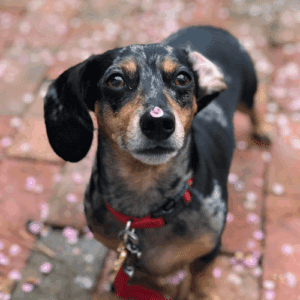
Meet Jordan and Winnie
Winnie, a sweet rescue, carried the invisible baggage of anxiety from day one. Thunderstorms, visitors, even the sound of a neighbor’s keys could send her cowering. Jordan had tried a handful of tips from friends and pet stores, but nothing seemed to make a lasting difference. After a friend told them about Good Human Dog Training, they decided to give science-based help a shot.
Jen arrived with empathy and a suitcase full of practical, gentle strategies. Instead of quick fixes, she focused on understanding Winnie’s triggers, creating management plans, and coaching Jordan to recognize and celebrate even the smallest wins. Most importantly, Jen helped the whole family set realistic expectations and taught them how to measure progress in weeks, not hours.
Six months later, Winnie is not only less anxious but also enjoys more peaceful walks and even greets visitors with a wag. Best of all, Jordan feels confident that they have a partner in Jen for any future bumps in the road.
“We honestly thought Win would always be nervous,” Jordan admits. “Now, she’s thriving.”
Meet Emily and Milo
When Emily adopted Milo, a German Wirehaired Pointer from his second home, she thought her running habit would keep him satisfied. Wrong. Without the activities he was bred for, he took out his frustrations by body-slamming Emily for attention and treating her furniture like chew toys. The day she came home to find her couch completely gutted, stuffing everywhere, Emily knew why Milo’s first family had given him up. That’s when Emily called Good Human Dog Training because living with a bored wire-haired pointer was like sharing her home with a tornado.
Enter Jen, who didn’t just train Milo; she equipped Emily with tools, resources, and the confidence to decode Milo’s doggy “language.” Through in-home sessions filled with patience (and humor), Emily learned how to spot subtle signs of over-arousal and redirect Milo’s breed instincts into brain games like scent work and puzzle feeders that actually tired him out, rather than winding him up. But the best part? Jen’s follow-up support continued long after the sessions had ended. Emily continues to draw from the resources and check-ins. Three months later, Milo is calmer, more focused, and Emily’s favorite running buddy.
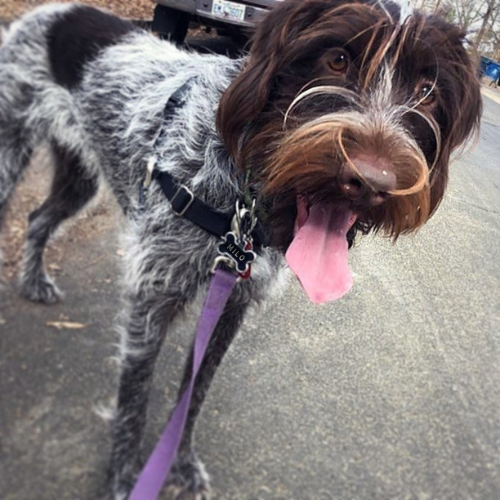
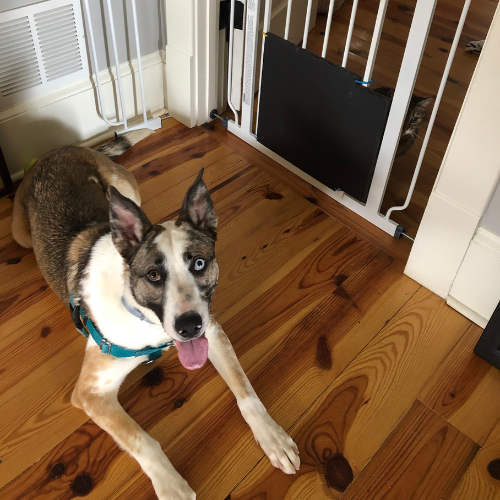
Meet Marcus and Luna
Luna’s kennel card said “good in a home with cats.” Within the first week, it became clear that “good with cats” meant something very different to the shelter than it did to Marcus. Luna spent her days stationed outside the cat room door, whining and pacing with intense focus that made everyone in the household uncomfortable. After a couple of management slip-ups that sent the cats scrambling and Luna into overdrive, Marcus knew he needed professional help.
Jen partnered with Marcus through a comprehensive assessment that addressed the needs of both species in the multi-pet household. She designed a sturdy management system that provided the cats with safe spaces and peace of mind, while also setting Luna up for success in training. Jen guided Marcus through muzzle conditioning to ensure safety during training sessions, then implemented a carefully structured desensitization program that gradually reduced Luna’s obsessive focus on the cats. Her expertise in creating customized protocols for each family member—feline, canine, and human—ensured steady and sustainable progress. Today, Luna is much less excited by the cats and can live with them safely.
“Honestly, I thought I’d have to choose between keeping Luna or keeping my sanity,” Marcus says. “Jen turned what felt like an impossible situation into something totally manageable. Now my house is actually peaceful again, and all three of them just do their own thing.”
Meet Emily and Jet
Lauren’s journey with Jet started three days after adoption when she realized the 2-year-old terrier mix from the local rescue came with challenges no one had mentioned. What began as excitement about her new companion quickly turned to fear and desperation as Jet’s reactive and aggressive behaviors escalated. Lauren was unprepared, overwhelmed, and seriously considering returning him to the rescue.
Jen partnered with Lauren through an emergency virtual consultation, immediately helping her understand the “why” behind Jet’s concerning behaviors. She educated Lauren about reactivity and trauma responses, as well as the critical importance of building trust through positive reinforcement training. Jen’s ability to break down complex behavioral science into practical, manageable steps ensured Lauren felt equipped rather than defeated. Their ongoing sessions focused on meaningful training protocols, reward-based techniques, and safety management strategies that transformed both dog and human. Today, Jet has blossomed into the happy, confident companion Lauren always hoped for, and she’s part of the growing community of Good Humans who understand that every dog needs a customized approach tailored specifically to them.
“I went from being afraid of my own dog to not being able to imagine life without my happy little guy,” Lauren says. “Jen taught me how to be the human Jet needed. We would not have made it without her guidance.”
